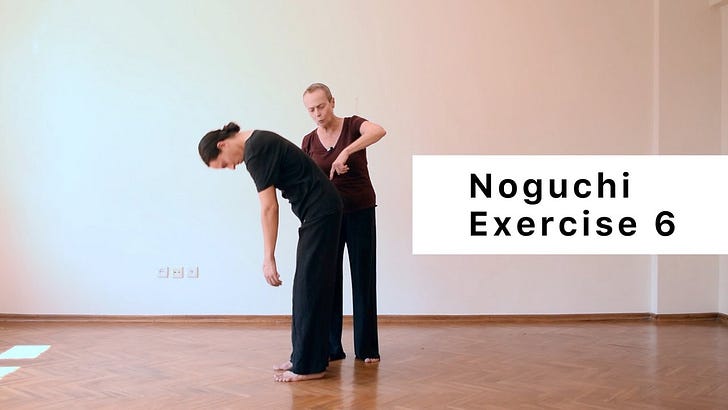Awareness Through Movement #420
In sitting, twisting with the eyes - NOGUCHI (aka "the dead bird")
AARGHHH… I forgot to press ‘post’ so it didn’t come through… I broke the cycle!!!
Mia Segal, Moshe’s first (and perhaps only) apprentice, introduced Moshe to Noguchi Taiso in Japan, where the two compared practices to discuss and learn with each other. Apparently, Noguchi laughed at how long it took Moshe to Functionally Integrate a movement, he only needed 5 minutes with what came to be know as the the Noguchi Taiso Method… and Moshe marvelled at Noguchi’s ways.
Noguchi was particularly impressed with this particular lesson, thereafter known by Mia, Leora and the Mind Body Studies as “the Noguchi” lesson. The Japanese master saw the way these movements fed through peoples’ spines, elongating the fascia, softening the nervous system… he thought it was ingenius according to the way Mia interpreted these meetings. I found this excerpt from a book you might find interesting, it’s called Bone, Breath, and Gesture: Practices of Embodiment Volume 1…. it notes some of Mia’s experiences in Japan.
When I asked Grok to explain how and why this lesson works… it summarised what I was wanting to say much more succinctly:
You’ll sit in different positions (one leg bent back the other bent forward), and gently twist your body while looking at your hand. Sometimes you’ll move your eyes and head together, and other times you’ll only move your eyes. You’ll also rest on your back between steps to let your body soak in what it’s learning. It’s slow and simple—no rush, no strain.
For example:
When you twist to the right and follow your hand with your eyes, your spine gets a gentle stretch, and your hips shift naturally.
When you move your eyes farther than your head, it’s like giving your brain a new map of how far your body can go—suddenly, turning feels easier.
What You Might Notice
Your neck or back might feel freer, like they’re not “stuck” anymore.
You could turn your head farther without trying hard—great for things like checking your blind spot while driving!
Walking or standing might feel smoother, as if your body’s parts are working together better.
Why Eyes Matter
Your eyes are like little coaches for your muscles, when you look in a particular direction, your body naturally wants to follow. This lesson uses that connection to help your spine twist more comfortably and your hips adjust without you even thinking about it. It’s a hidden trick your body already knows—you’re just waking it up!
Personally, I think the range between our eyes and what we see… all that which is in between is a part of our “Selves”.
The attention we bring to these area are included as a part of us… even the parts we don’t want to see, or to know… it’s a theory I’m working on how to make sense of… Feldenkrais is assisting the verbalisation of what can be felt during a lesson - particularly lessons like this one that invite us to *use* the eyes for more than simply “seeing”.
Whichever way YOU see it, enjoy learning more about your Self, in movement.
Keep reading with a 7-day free trial
Subscribe to MySelf.Study to keep reading this post and get 7 days of free access to the full post archives.



